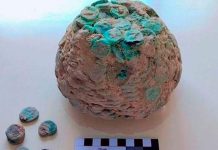IDENTIFICATION
Desert Wheatear virtually all-black tail is shared only by Red-rumped Wheatear, although it should be borne in mind that many wheatears appear black-tailed when the tail is closed and may not always spread the tail to reveal a true pattern even in flight. Male recalls the black-throated form of Black-eared, but apart from the tail pattern may be separated by having a black face/throat connected to the black of wings, narrower buffish white rump patch, sandy (rather than all or mostly black) scapulars, white inner wing coverts (forming contrasting white margin to outer wing) and more extensive sandy fringes to wing feathers.
Male Finsch’s has black scapulars and a tail pattern as Northern. In fresh autumn plumage, the black face/throat is partially obscured by sandy mottling, and likewise the black sides of the neck, give the appearance of a break between the throat and wings. The female is pale sandy overall and recalls Isabelline in this respect, but Desert is stockier, with a more rounded head, weaker bill, shorter legs, slightly longer tail, and less upright stance.

It shares Isabelline’s largely whitish underwing and some Isabelline have a very short central bar to the inverted black ‘T’ on the tail (thus suggesting Desert’s rear end pattern), but Desert has a tail dark virtually to the base, much larger pale rump patch (tinged with pinkish-buff when fresh) and much darker wings when worn (i.e. in spring/early summer).
In fresh plumage in autumn, broad pale fringes largely obscure dark centers to wing feathers, and at this time black alula can stand out, almost as much as it does in Isabelline. Unlike Isabelline, lesser coverts often appear paler than upper parts, and (as in Northern) black centers to median coverts stand out as a row of black spots (centers much browner and less contrasting in Isabelline).
Facial patterns may differ subtly; supercilium averages are less prominent, ear coverts are sometimes rusty-brown and darker than the crown (a contrast lacking in Isabelline), and anterior lore is never dark (although it may seem to be in some light conditions). Adult females may show some dark on the throat when worn and pale inner wing coverts typically show up as a pale line between the outer wing and mantle/scapulars.
All-dark tail differentiates Desert from occasional abnormally pale individuals of Northern or other wheatear species. Very much a bird of flat arid country with scattered bushes, on which it readily perches.
SEX/AGE
DESERT WHEATEAR Wings blacker in worn spring/early summer plumage; pattern obscured by broad sandy fringes and rump-washed buff when fresh in autumn. The juvenile resembles an adult female but is indistinctly mottled above and on the breast. 1st-years in autumn resemble respective adults, but 1st-year males have broader pale fringes to wing feathers and to the black of the throat, usually totally obscuring the throat center; 1st-year females are not safely separable from adult females. By the first spring as adults and wings of males are browner and more heavily worn, than in adults.
VOICE
DESERT WHEATEAR call typically includes a low ‘tchuk’, a low whistled ‘peeeoo’ and a rolling, almost lark-like ‘trrr’. The song consists of low, plaintive, descending whistles (e.g. ‘swee-you’ or ‘sweerer-you’) interspersed with short, harsh trills or rattles and long pauses; typically uttered from bushtop.

GEOGRAPHICAL VARIATION
Slight. 3 race differences are based on the tone of a buff of upper parts and size; much local variation and intergradation complicate distinctions. N African homochroa is smaller and more pinkish-buff, less greyish-buff than the nominate race. C Asian race atrogularis (breeds from Transcaucasia eastwards) is browner above and slightly larger than nominate race, with more extensive white on the inner webs of flight feathers and more extensive black on the throat.
STATUS/HABITAT
DESERT WHEATEAR is locally common. Flat, open desert, semidesert or very arid steppe, and also wadis, with either stony or sandy substrate and scattered bushes. The bird breeds on the high plateau as well as in the lowlands. The on passage and in winter also about fringes of cultivation







